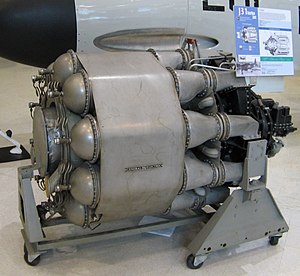General Electric J31
| J31 | |
|---|---|
 |
|
| General Electric J31 turbojet engine | |
| Type | Turbojet |
| National origin | United States |
| Manufacturer | General Electric |
| First run | April 1943 |
| Major applications |
P-59 Airacomet Ryan FR Fireball |
| Developed from | Power Jets W.2B/23 |
| Developed into | General Electric I-40/Allison J33 |
The General Electric J31 was the first jet engine to be mass-produced in the United States.
After a visit to England mid-1941, General Henry H. Arnold was so impressed by flight demonstrations of the Gloster E.28/39 jet aircraft he had witnessed that he arranged for the Power Jets W.1X turbojet engine to be shipped by air to the U.S, along with drawings for the more powerful W.2B/23 engine, so that the US could develop its own jet engine.
General Electric's extensive experience in turbocharger production made them the natural choice for producing such an engine. The initial prototype, the General Electric I-A, was essentially based on the Power Jets W.2B/23. It first ran on 18 April 1942 and developed a static thrust of 1250lbf.
The I-A air intake consisted of two peripheral slots which led to a double-sided, centrifugal compressor. A series of vanes guided the air into the impeller eyes. After radial compression, the air was diffused and turned 90 degrees rearwards, before entering a set of ten reverse-flow combustion chambers (i.e. cans). A relatively short shaft connected the compression system to the single stage axial turbine. After expansion through the turbine, the combustion products exhausted the engine through the simple conical propelling nozzle, via the jet-pipe.
Using their turbocharger expertise, General Electric were able to, in a short space of time, develop a 1400lf thrust version, known as the I-14. Later they increased the thrust to 1610lbf. This version was referred to internally as the I-16 However, the United States Army Air Forces later decided to standardise all their jet engine naming, at which point the I-16 became the J31.
Production of the J31 started for the P-59 Airacomet in 1943, and by the time the lines shut down in 1945, a total of 241 had been built. GE also used the basic design to produce the much larger I-40 with 4,000 lbf, but this design was passed on to Allison as the J33, much to GE's chagrin. Another derivative of the J31, the General Electric I-20, given the military designation J39, was ordered but later cancelled.
...
Wikipedia
